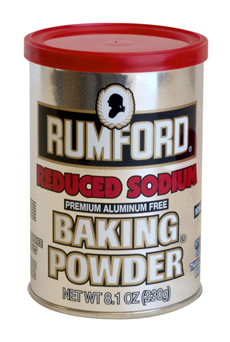TIP OF THE DAY: Make Your Own Baking Powder, Plus Low Sodium Baking Powder
 Reduce the sodium in your baking powder by 40%. Photo courtesy Rumford/Clabber Girl. |
If you bake biscuits, cakes, from-scratch pancakes, muffins, quick breads and scones, you’ve no doubt used baking powder. Baking powder is a dry chemical leavening agent that is used to increase the volume and lighten the texture of these types of baked goods. When it makes contact with a liquid (like the liquid in a batter), it releases carbon dioxide gas, causing bubbles that expand (“leaven”) the mixture. Hence, a light and fluffy cake, or a scone that isn’t leaden. Yeasts also produce this kind of reaction, but bring their signature “yeasty” flavors with them. They taste great in bread and in yeast cakes, but not in a conventional cake or muffin. Here are some things you may not know about baking powder—but should—along with a recipe for homemade baking powder (easy!). Aluminum In Baking Powder Baking powders are available both with and without aluminum compounds. Sodium aluminum sulfate is added to some baking powders to create the “double acting” effect. This is a convenience for the baker, since it delays the expansion of the batter for 15 to 20 minutes, without losing the leavening power. This means that the batter doesn’t have to be rushed into the oven shortly after the baking powder is added.* |
|
|
This is particularly important in commercial baking, where many pans of batter can be lined for a period of time before going into the oven. But it isn’t critical for home baking. *Double acting baking powder reacts to the liquid and heat in two stages. The first reaction takes place when the baking powder makes contact with the batter, and reacts with the liquid to produce carbon dioxide gas. The second reaction takes place when the batter responds to the heat in the oven (the gas cells expand, causing the batter to rise). There are two reasons to avoid baking powder with aluminum. Some people with finely-tuned palates perceive a tinny aftertaste. But more importantly, scientists are pursuing a possible link between aluminum consumption and Alzheimer’s disease, attention deficit disorder, bone degeneration, kidney dysfunction and even Parkinson’s disease. Baking powder without aluminum costs a bit more than standard baking powder. But it’s worth it. You should notice an improved flavor in your baked goods. Baking Powder Can Go Flat If you don’t bake regularly, chances are that you’ve had the same can of baking powder for years. Over time, it can go flat. To test if your baking powder is still good, add a teaspoon to a half cup of boiling water. If you see a bubbling reaction, the baking powder is good. If not, toss the powder, recycle the can and buy more when you’re ready to bake again. Reduced Sodium Baking Powder Given that baking powder’s principal ingredient is sodium bicarbonate,† a standard baking powder can deliver a lot of hidden sodium. One muffin, for example, can contain almost 20% of the Recommended Daily Allowance of sodium. So if you’re watching your salt intake or just prefer healthier ingredients, look for a reduced-sodium baking powder. They’ve been around for a while, but have produced baked goods that are less light and fluffy. The Rumford brand has just launched a new formula that is quick-acting, is used in the same amount as regular baking powder and produces baked goods that are light and fluffy. It contains 52% less sodium than conventional brands. And it’s aluminum-free. If you can’t find it locally, you can purchase it from the company’s website. If you don’t use baking powder often, it might make more sense to make your own baking powder and have one less item cluttering the shelf. For one tablespoon of baking powder, thoroughly combine: If you’re not going to use it immediately, you can store it (or any excess) in an airtight container if you add: |
||